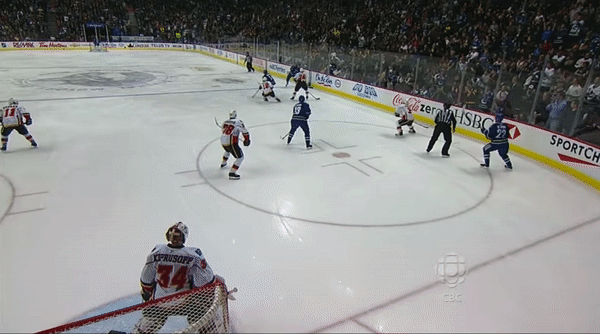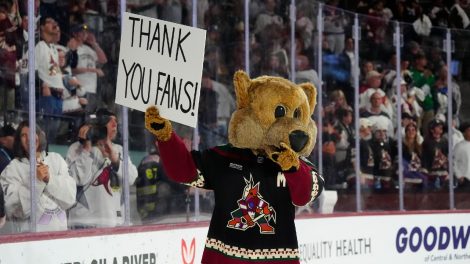Look past the sibling novelty for a moment.
The matching haircuts, the identically manicured goatees, the sometimes uncanny synchronicity — it was all well and good. But beyond all that, Henrik and Daniel Sedin were simply one of the most dominant duos to ever take the ice in the NHL. That they were brothers was just an added wrinkle to their historic offensive reign over the West.
But, to be fair, the Sedins’ time in Vancouver was never short on intriguing wrinkles. The fact that the brothers wound up on the same NHL club initially seemed a miracle enough. That their intuitive chemistry translated so seamlessly to the big leagues was yet another bonus for the Vancouver Canucks faithful. But as the famed twins’ careers wore on, our understanding of just how unique they were got lost.
We became so accustomed to the Sedins’ greatness that their wholly inimitable presence in the game became commonplace. They were, of course, no strangers to reminding us that it was anything but — of showing us instances of their intuitive chemistry that went beyond even our most generous expectations of two players who’d spent their entire lives alongside each other:

But the synchronized magic of their game was the least of the oddities. There was also the historic context of their career-best campaigns — the fact that Henrik and Daniel each had exactly one 100-point season on their resumé, one after another in 2010 and 2011, and that, incredibly, those campaigns netted each twin a scoring title, in back-to-back years.
By far the most uncanny moment during the twins’ NHL tenure came in their final game in Vancouver, though, a wild evening for Nos. 22 and 33 as they closed out their careers as Canucks at home.
First came a goal 33 seconds into the middle frame from Daniel (his 22nd goal of the year, of course), assisted by Henrik. Then, with the game fittingly tied 3-3 at the end of regulation, an overtime winner from Daniel, assisted by Henrik, at 2:33 of the extra frame — or 22:33 of the third period, if you really want to stretch the numeric fate thin.
More? How about this: It was Alex Edler, No. 23, who got the other helper on both of Daniel’s goals that night, the latter of those tallies ranking as Daniel’s 23rd of the year. With a 7:07 p.m. start time and 9:37 p.m. end time, the game lasted exactly 2:30. Vancouver won exactly 33 faceoffs in that tilt, while their opponent, Arizona, won exactly 22. The Canucks earned an edge in power-play opportunities that evening, 3-2 — and their success rate on the power play that game after Daniel’s overtime winner was, of course, 33.33 per cent.
Given how all those power plays shook out, and the time elapsed before that overtime tally was scored, when all was said and done the game’s total even-strength minutes played sat at 56:22, while the total minutes played sat at 62:33.
With the Canucks set to retire those fated digits to the rafters Wednesday night, let’s take a look back at some other noteworthy numbers that tell the story of the Sedins’ 17 years in the big leagues:
[relatedlinks]
1: As mentioned above, one of the wildest accomplishments of the twins’ careers was their back-to-back run atop the league’s scoring race. In earning those consecutive distinctions, they became the one and only pair of siblings to both win the Art Ross Trophy.
2: Beyond the brother bond, Henrik and Daniel also simply had an unprecedented run as teammates. By the time they’d hung up the dream, the pair had played the second-most games together of any pair of teammates in NHL history, with only the ageless Gordie Howe and Alex Delvecchio besting them.
3: While the offensive totals amassed tell one side of the story of the Sedins’ impact in Vancouver, their trophy case speaks to another. In 2018, Henrik and Daniel were named co-winners of the league’s King Clancy Memorial Trophy, awarded to a player “who best exemplifies leadership qualities both on and off the ice and has made a significant humanitarian contribution in his community.” In earning his first King Clancy that year, Daniel became the third Canuck to ever win the trophy, following his brother Henrik and Trevor Linden. Henrik, in turn, became the only player to win multiple King Clancy trophies during his career, while the brothers also became the first co-winners of the award.
4: A world in which the Sedins didn’t suit up together would be a world we would want no part of. In both getting the nod in the first round in ’99, they became one of four pairs of brothers to both earn first-round selections from the same franchise. The others: Dave and Mark Hunter in Montreal, Duane and Brent Sutter for the Islanders, and more recently, Callan and Nolan Foote in Tampa Bay.
5: Impressive by sibling standards, the Sedins are no less impressive among the pantheon of the great Swedes who’ve graced the NHL with their talent. Both Henrik and Daniel rank among the top five Swedish scorers in NHL history, coming in at Nos. 4 and 5, respectively. Daniel’s 393 goals rank him fifth among all-time Swedish NHLers in that category, while Henrik’s 830 assists rank him second all-time among Swedish playmakers in the big leagues.
6: As noted in Iain MacIntyre’s recent piece reflecting on the Sedins’ career and their enduring bond in retirement, the twins were in fact born six minutes apart back on Sept. 26, 1980. Six minutes? Two times three? Never mind.
16: Given all they’ve done together, it’s almost difficult to view either Henrik or Daniel in isolation, but given how different their skill-sets and impacts on games were, there’s plenty of individual accolades for the brothers. One of Daniel’s great distinctions: being among the most clutch scorers in history. He ranks tied for fourth all-time in career overtime winners with 16 to his name, only Alex Ovechkin (23), Jaromir Jagr (19), and Ilya Kovalchuk (17) sitting above him. Tied with Daniel at 16? Sidney Crosby and Patrik Elias. Henrik’s career was, of course, just as dominant if viewed on its own — from the time the centreman debuted in 2000-01 to right now in 2020, only four players amassed more points than him: Joe Thornton, Ovechkin, Crosby and Jarome Iginla.
90: In 2010-11, the brothers went on a tear to post a combined 198 points, with 104 of those claiming the Art Ross Trophy for Daniel. In doing so, the duo became only the second pair of brothers to ever top the 90-point plateau in the same season — the others being Peter and Anton Stastny in 1982-83.
743: Over the course of their time in Canucks colours, Henrik and Daniel combined on 743 goals for Vancouver. That sum ranks as the second-most ever amassed by two teammates together. Only Wayne Gretzky and Jari Kurri combined on more tallies, connecting on 764 during their time together. Overall, at least one of the Sedin brothers factored in on 1,363 of 3,799 total Canucks goals scored during their tenure, good for 36 per cent of the club’s total offensive output.
1,000: You can weave a whole web of intriguing numbers based only around the fact that both Henrik and Daniel managed to surpass 1,000 points during their NHL careers. In doing so, they became the only siblings in league history to each reach that plateau. They’re also the only Canucks to ever do so, and only the fourth and fifth Swedes to ever do so. Their combined 2,107 points makes them the fourth-highest-scoring sibling duo of all time, behind the six Sutter brothers (who posted a combined 2,936), the Gretzky brothers (who very much equally contributed to their 2,861), and the Stastnys (who posted 2,169). In terms of sibling duos, the Sedins are topped only by the Gretzky(s).
1,300: Finishing with the most games in a Canucks sweater, Henrik and Daniel each surpassed the 1,300-game mark before all was said and done in their career — in doing so, they joined a select group of all-timers who logged 1,300 games with one NHL club. The only others in that loyalty club: Nicklas Lidstrom, Alex Delvecchio, Shane Doan, Steve Yzerman, Joe Sakic, Stan Mikita.
6,752: In October 2018, the Canucks begrudgingly began the post-Sedin era in Vancouver. The moment was made more poignant by the fact that, over the course of the twins’ entire 17-year career, there wasn’t a single Canucks game that didn’t feature at least one of them in the lineup. The exact time in between games featuring zero Sedins: 6,752 days and 1,465 total games.









